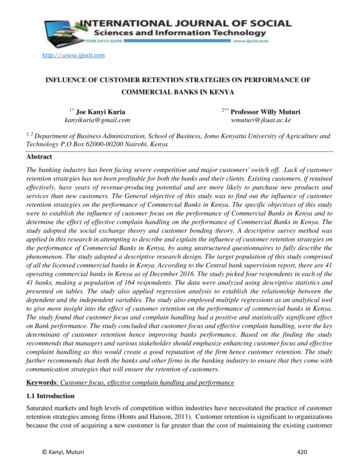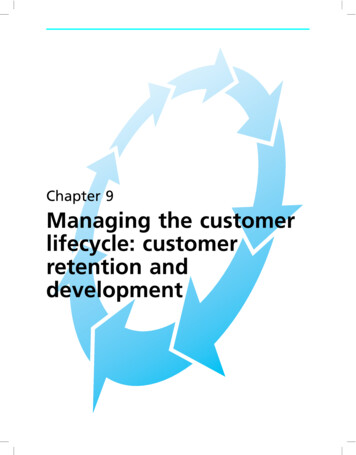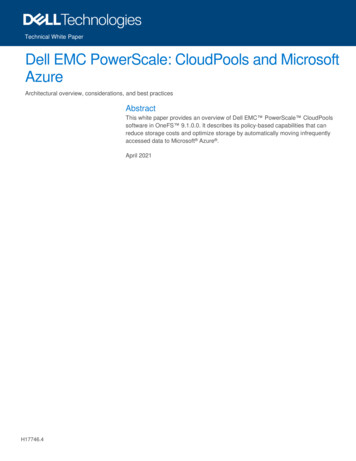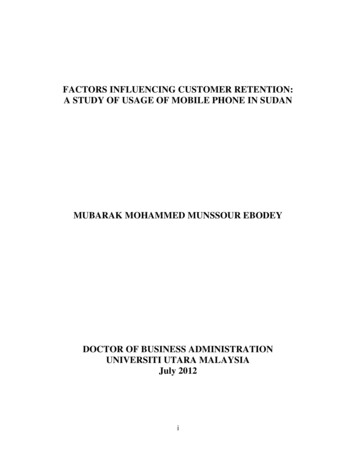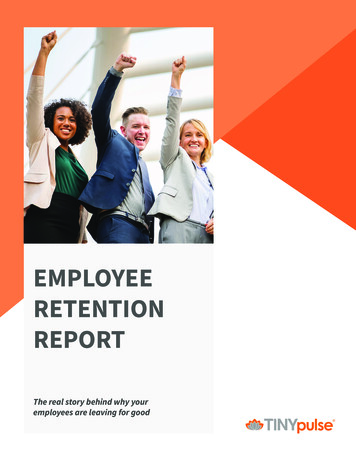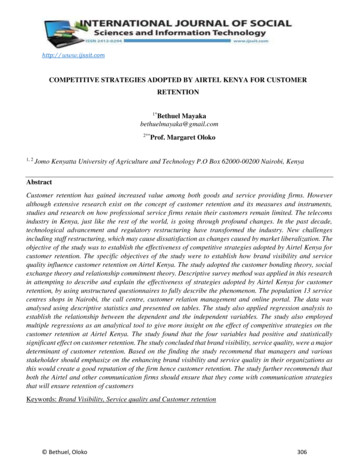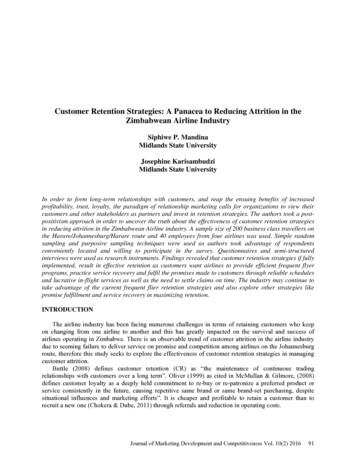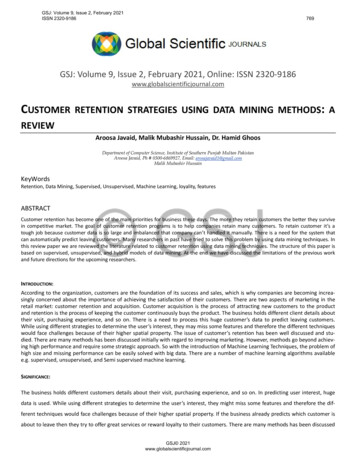
Transcription
GSJ: Volume 9, Issue 2, February 2021ISSN 2320-9186769GSJ: Volume 9, Issue 2, February 2021, Online: ISSN TENTION STRATEGIES USING DATA MINING METHODS: AREVIEWAroosa Javaid, Malik Mubashir Hussain, Dr. Hamid GhoosDepartment of Computer Science, Institute of Southern Punjab Multan PakistanAroosa Javaid, Ph # 0300-6869927, Email: arosajavaid1@gmail.comMalik Mubashir HussainKeyWordsRetention, Data Mining, Supervised, Unsupervised, Machine Learning, loyality, featuresABSTRACTCustomer retention has become one of the main priorities for business these days. The more they retain customers the better they survivein competitive market. The goal of customer retention programs is to help companies retain many customers. To retain customer it’s atough job because customer data is so large and imbalanced that company can’t handled it manually. There is a need for the system thatcan automatically predict leaving customers. Many researchers in past have tried to solve this problem by using data mining techniques. Inthis review paper we are reviewed the literature related to customer retention using data mining techniques. The structure of this paper isbased on supervised, unsupervised, and hybrid models of data mining. At the end we have discussed the limitations of the previous workand future directions for the upcoming researchers.INTRODUCTION:According to the organization, customers are the foundation of its success and sales, which is why companies are becoming increasingly concerned about the importance of achieving the satisfaction of their customers. There are two aspects of marketing in theretail market: customer retention and acquisition. Customer acquisition is the process of attracting new customers to the productand retention is the process of keeping the customer continuously buys the product. The business holds different client details abouttheir visit, purchasing experience, and so on. There is a need to process this huge customer’s data to predict leaving customers.While using different strategies to determine the user’s interest, they may miss some features and therefore the different techniqueswould face challenges because of their higher spatial property. The issue of customer’s retention has been well discussed and studied. There are many methods has been discussed initially with regard to improving marketing. However, methods go beyond achieving high performance and require some strategic approach. So with the introduction of Machine Learning Techniques, the problem ofhigh size and missing performance can be easily solved with big data. There are a number of machine learning algorithms availablee.g. supervised, unsupervised, and Semi supervised machine learning.SIGNIFICANCE:The business holds different customers details about their visit, purchasing experience, and so on. In predicting user interest, hugedata is used. While using different strategies to determine the user’s interest, they might miss some features and therefore the different techniques would face challenges because of their higher spatial property. If the business already predicts which customer isabout to leave then they try to offer great services or reward loyalty to their customers. There are many methods has been discussedGSJ 2021www.globalscientificjournal.com
GSJ: Volume 9, Issue 2, February 2021ISSN 2320-9186770initially with regard to improving marketing. However, methods are difficult to achieve high performance and require some strategicapproach. So by using machine learning algorithms and feature selection methods key features are selected from huge data thathelps the business increase customer retention.BACKGROUND:Customer retention means the willingness of an organization to combine business with a particular customer or to continuously adjust to their requirement. Retention can also be characterized as the willingness of love, identity, commitment, trust and client torecommended and repeat purchases. It is important for the success of any businesses to establish successful customer’s relationship. For the growth of businesses, customer satisfaction, retention, good words of mouth and loyalty are important. In addition,existing research on online customer retention is limited. Many businesses currently fail to attract new customers in order to maintain a suitable marketing department and assign mangers to pay attention to their existing customers. Most previous studies haveconcentrated on customer loyalty in restaurants, telecommunication firms, hotels and other services, although less attention hasbeen given to customer retention in a retail industry.DATA MININGData mining is a method used to predict customer retention. Data mining involves extracting information from a huge data and converting it into an easily interpretable system that enables organization to evaluate complex problems that result in customer loyaltyand turn over to companies. Data mining provided many algorithms that we can use in the prediction of customer retention.Supervised Machine Learninga.b.ClassificationUnsupervised Machine Learningc.Clustering Algorithmi. Naïve Bayesi. Hierarchal Clusteringii. Random Forestii. Gaussian Mixtureiii. Nearest Neighboriii. Neural Networksiv. Discriminant Analysisiv. C-Meansv. Support vector Machinev. FuzzyRegressionvi. Hidden Markov Modeli. Linear Regression GLMvii. K-medoidsii. SVR, GPRviii. K-Meansiii. Ensemble Methodologyix. KNNiv. Decision Treev. Neural Networkvi.Boostingvii. Baggingviii. StackingSupervisedNaveen et.al (2020) predicted customer churn and relation model by using Machine Learning methods on cell2cell and IBM datasets.GSJ 2021www.globalscientificjournal.com
GSJ: Volume 9, Issue 2, February 2021ISSN 2320-9186771They had predicted 30 variables and implemented Naïve Bayes, Decision Tree (DT) and Support Vector Machine (SVM). The outcomeof their model was measured by using the Area under the curve (AUC) and gained 0.87, 0.82, and 0.77 for IBM and 0.98, 0.99 and0.98 for the cell2cell dataset. On the other hand, Hyun et.al (2020) utilized the US-based telecommunication company dataset forthe analysis of customer switching behavior and they implemented data cleaning and data balancing Pre-processing techniques.They had utilized some machine learning approaches Logistic regression (LR), Vector machine, Random Forest (RF) and DT. The outcomes of their model demonstrate that the predicted performance of their work is greater than 86% and the LR has the highest accuracy rate. They suggested using other data mining methods to create a predictable model similar to the ANN and Bayesian networks that were able to improve their research.Hemlata et.al (2020) classifies the customer churn by using Supervised Machine Learning. They utilized some preprocessing strategies for data acquisition and cleaning. They grouped the dataset into training and testing that is acquired from an online source. Theyhad implemented KNN (K-nearest Neighbors) and XGBoost Algorithms. Thus as that conclusion, KNN gains 83.85% accuracy with higherror and low sensitivity and specificity while on the other hand, XGBoost gains accuracy of 86.85% with low error and high sensitivity and clarity. While, Shreyas Rajesh (2020) implemented machine learning algorithms, Extra Trees Classifier, XGBoosting Algorithm,SVM, SGD Classifier, AdaBoost Classifier, Gaussian Naive Bayes and LR to recognize the customer churn. He used BigML churn Telecom dataset and utilized some preprocessing strategies handling missing values, encoding categorical data, dividing the dataset intotest and train sets, and feature scaling. The detection of their work was the Extra Tree classifier, XGBoosting Algorithm, and SVM wasthe finest with AUC score (0.8439, 0.78, and 0.735) respectively.Sahar F. Sabbe (2018) used a public dataset of customers in the Telecom industry, took 60% of training and 40% of the testing dataset. He implemented machine learning techniques, DT (CART), SVM, KNN, Adaboost, RF, Stochastic gradient boost, and MLP ANN andupholds some pre-processing techniques like data cleaning, transformation, and feature selection. Thus the outcome of their workthat RF and AdaBoost output performance is the same with the accuracy of 96%. Multilayer Perceptron and SVM give an accuracy of94%. DT gives 90%, Naive Bayesian 88%, and LR and LDA give 86.70%. Hence RF and Adaboost give the best output performance.This research is extended by including deep learning and a hybrid model. On the other hand, Nagraj et.al (2018) purposed customerretention by upholding some machine learning algorithms ANN, SVM, and Deep Neural Network DNN and they took two datasetsone of German credit second of a bank customer. They had applied pre-processing technique Normalization in the customer bankdataset. They had achieved the accuracy of 98%, 92%, and 97% for ANN, SVM, and DNN respectively and for bank customer data and72%, 76% and 72%, respectively for the credit dataset of German. ANN gives better accuracy for bank customer data while DNN givesbetter accuracy for the German credit dataset.Machine learning algorithms KNN, CART, and SVM used by Pushpa et.al (2019) for customer retention. They had utilized Normalization on the customer dataset which is self-generated. The outcomes indicate that the KNN classifier is better than CART and SVM.The accuracy of KNN, CART, and SVM are 0.96, 0.95, and 0.94 respectively. They suggested that their work can be used to find applications in the 5th Generation of mobile communication where user retention is important. On the other hand, Vijaya et.al (2019)proposed feature selecting techniques by using two different datasets from French Telecommunication orange company KDD Cup(2009) and implemented some pre-processing data cleaning and random oversampling. They used DT, KNN, SVM, NB, and ANN. Theoutcome indicates that SVM gains higher accuracy of 91.66% with imbalanced data and KNN gains 93.9% with random oversampling.They had suggested in the future more advanced methodology is used for feature selection.Zhen et.al (2012) Proposed Hierarchical Multiple Kernel Support Vector Machine (H-MK-SVM) for the customer churns using longitudinal behavioral data. They used three datasets extracted from AdventureWorks DW, real-world databases Foodmart 2000 and TeleGSJ 2021www.globalscientificjournal.com
GSJ: Volume 9, Issue 2, February 2021ISSN 2320-9186772com. They had implemented sampling and Normalization. The outcome of their Proposed was H-MK-SVM shows Superior performance on both imbalanced and balanced data as compare to SVM and MK-SVM. The accuracy of H-MK-SVM, SVM and MK-SVM, onbalanced data is 76.31%, 70.0% and 70.65%, respectively. While XGBoost method is used by Atallah et.al (2020) for customer retention. They used the self-generated dataset of 5000 subscribers and perform some sampling methods oversampling, ADASYN, SMOTE,and Borderline –SMOTE. The outcomes of their research were oversampling method improved the performance of Gradient BoostedTrees 84% by SMOTE oversampling of ratio 20%. On the other hand, Ahmet et.al (2020) used a machine algorithm for user behaviorprediction. They have used the self-generated dataset of 50 features and apply pre-processing feature encoding, feature extraction,pseudonymization, missing feature, and normalization. The outcomes of their work that the Gradient boosting algorithm performsbetter than other algorithms.Machine Learning methods DT, Gradient boosted Machine Tree (GBM), RF, and Extreme Gradient boosting (XGBoost) used by Abdelrahim et.al (2019) for prediction of churn in Telecom. They had used SyriaTel telecom company dataset and apply some preprocessing techniques oversampling and Undersampling. The result of their work is that XGBoost gives a better performance of 93%.On the other hand, Afaq et.al (2010) implementing data mining in ISP for customer churn. They used a dataset from Spenta Co. andutilized some pre-processing techniques feature extraction and modeling. They uphold some methods DT, LR and NN algorithm. Theoutcome indicated that their model achieved an accuracy of 89.08% in churn prediction rate by using feed-forward Neural Networks.while, Vafeiadis et.al (2015) analyzed the comparison of machine learning by using ANN, SVMs, DTs, Naïve Bayes, and LR and theyused a public domain dataset. The outcomes indicate that support machine classifier poly with AdaBoost gain accuracy of 97% and Fmeasure over 84%.Kiansing et.al (2001) proposed customer retention via data mining they used dataset from a transactional database residing inOracle and performed deviation analysis and feature selection techniques on the dataset. They had utilized DT induction. This modelgives the proposal that data mining gives a good consequence for customer retention. This Model further demonstrates that the context of particle application of data mining is much an art. On the other hand, Ridwan et.al (2015) operated NN Analysis, MultipleRegression Analysis, and LR Analysis for the customer churn prediction and implemented feature extraction based on nine-month ofthe bills and normalization on the dataset that is extracted from the warehouse of a Telecommunication company. The outcome oftheir experiment is that NN gain the best accuracy of 91.28%.Data mining techniques DT and CART (Classification and regression Tree) used by Chitra et.al (2011) for the customer retention ofthe bank. They had used the bank dataset and implemented data reduction on the given dataset. The outcome of their work thatCART (Classification and regression Tree) gives the overall greater classification rate. On the other hand, RF and Regression Forestused by Bart et.al (2005) for customer retention and profitability. They make use of a dataset from warehouse of a large Europeanfinancial Service Company and applied data validation and sampling on it. They conclude their model provided a better estimate andvalidation sample as a match to the regression model.Preeti et.al (2016) used LR and DT in the Telecom industry for the customer churn prediction and they utilized the dataset from Telecom Company and applied data cleaning for making the system robust and feature extraction for the generation rules for the DT andestimation of parameters in LR The outcome of their work was by using both DT and LR is best to design customer retention and itwill also easy to design or maintain the customer with a high probability to churn. On the other hand, UCI database of the Universityof California home telecommunication dataset was used and some preprocessing techniques data acquisition and oversampling alsoapplied on it by XIA et.al (2008) for customer churn prediction. They had utilized SVM, ANN, DT, Naïve Bayesian Classifier, and LR, theoutcome of their work were SVM give the better accuracy rat, strong generation ability, and good fitting Precision.GSJ 2021www.globalscientificjournal.com
GSJ: Volume 9, Issue 2, February 2021ISSN 2320-9186773Yu Zhao at. el (2005) presented improved one-class SVM for customer churn and used the subscriber database provided by theOracle dataset. They compare their model with traditional methods DT, ANN, and Naïve Bayesian Classifier and the accuracy rate oftheir comparison SVM, ANN, DT, and Naïve Bayesian Classifier gain were 78.1%, 62%, 83.24%, and 87.15% respectively. Their Modelshows a better accuracy rate than the other. They suggested that more research be done on how to select the appropriate kernelparameters and input features to get accurate results. While, Mohammed al. el (2015) used a dataset of UK mobile Telecommunication operator data of warehouse and they applied some data preparation processes discretisation of numerical variables, imputationof missing values, transformation from one set off discrete values to another, new variable derivation, and feature selection of themost informative variables. They had utilized LR and DT and the outcome of their work DT was Preferable for the customer churn andaccuracy rate of DT was 70% and LR was 68%.Abbas et.al (2016) used Electronic bank customer data from the bank’s database and applied it to preprocess data cleaning, featureselection, and sampling on it. They used DT and the accuracy of DT was 99.70%. on the other hand, Applications of AdaBoost (Real,General, and Modest) utilized by Shao et.al (2007) for the churn prediction and they used a dataset provided by anonymous bank inChina. They implemented some preprocessing handling of missing values and sampling. As a result of their model, these algorithmsare proven improved for the predicting accuracy than the other algorithm.Yaya et.al (2009) used improved balanced RF for churn prediction and they used the real bank customer dataset. They applied asampling technique to the given dataset. The outcome of their research IBRF produced better accuracy than the other RF algorithm(balanced and weighted random forest). It offered great potential due to scalability, running speed, and faster training. On the otherhand, Lonut et.al (2016) presented churn prediction for pre-paid mobile industry by using Neural Network, SVM, and Bayesian Network. They used the dataset of pre-paid mobile telecommunication industry and implemented data modeling on it. The outcome oftheir model was overall accuracy of 99.10% for Bayesian Network, 99.55% for NN, and 99.70% for SVM.Suban et.al (2016) presented customer retention of MCDR by using data mining approaches Naïve Bayes, Radial Basis Function Network, Random Tree, and J48 Algorithm. They used two different datasets Dataset PAKDD 2006 available in “dat” and dataset of 3Gnetwork by an Asian Telco operator. They had applied some pre-processing handling missing values and Chi-square feature selectionon the given datasets. The outcome of their research was Random Tree with three staged classifiers Chi2 gives the high accuracy rateof 87.67%. while, LI-SHANG et.al (2006) proposed knowledge discovery for customer churn by using DT and Logistic Regression. Theyutilized had customer dataset from the data warehouse and implemented sample extraction on it. The outcome of their model wasDT performed better than the Logistic Regression. Similarly, Ali et.al (2004) proposed customer churn and retention by using SimpleDT, DT with cost-sensitive DT, Boosting, and Logistic Regression. They used the customer dataset of major Australian online fastmoving consumer goods and implemented sampling. The outcome of their proposed model was AUC measurement shows differentperformance by the area under the ROC curve are 0.83, 0.91, 0.85, and 0.92 for Cost-Sensitive DT, LR, Simple DT and Boosting respectively.Hongmei et.al (2008) Proposed GA- based Naïve Bayesian Classifier for the prediction of customer retention. They used dataset fromJapanese credit debit and credit companies. They used a genetic algorithm for feature selection and the outcomes was comparedwith NB, TAN, and APRI classifier and indicate GA-based identified customer churn is better for a large number of customers showshigher classifying precision. On the other hand, Ali et.al (2015) predicted customer churn by using Echo State Network (ESN) andSVM. They used two different datasets one KDD dataset and the other from a Jordanian cellular telecommunication company. Theoutcome of their work was accuracy rate for the KDD dataset of ESN with SVM-readout was 93.7% and 87.9% and for the datasetfrom Jordain cellular telecommunication company was 99.2% and 96.8% respectively.GSJ 2021www.globalscientificjournal.com
GSJ: Volume 9, Issue 2, February 2021ISSN 2320-9186774Zaho et.al (2008) presented a support vector machine for churn prediction and compares their result with the DT (C4.5), Logisticregression, ANN, and Naïve Bayesian classifier. They used a dataset of VIP customer's domestic branch of CCB as the core data andimplemented sampling. The output of their work SVM with the higher accuracy rate of 0.5974, 0.5148 for C4.5, 0.5890 for LR, 0.5549for Naïve Bayesian Classifier, and 0.5479 for ANN. On the other hand, Shin et.al (2006) proposed telecom churn management by using DT and Neural networks. They utilized random sampling on a dataset gained from wireless telecom companies in Taiwan. Theoutput of their work was Both DT and NN give accurate churn prediction. Similarly, Michael et.al (2000) predicted improving retention and subscriber dissatisfaction by using LR, DT, NN, and Boosting. They used the dataset provided by the wireless carriers andutilized the outcome of their prediction was NN gives better nonlinear structure in the sophisticated representation than the DT, LR,and Boosting.Jae et.al (2005) detected the change in customer behavior by using DT and used Dataset from a Korean online shopping mall. Theyhad utilized data cleaning and discretization. The output of their detection was DT based methodology can be used to detect thechanges of customer behavior from sales data and customer profile at different times. They suggested in future, this methodologycan be extended to discover changes in customer behavior for three or more dataset. On the other hand, Kristof et.al (2017) proposed customer churn prediction by using LR and used Dataset provided by a large European mobile telecommunication provider.They implemented data cleaning, data reduction, sampling, missing value handling, and outlier. The outcome of their proposed wasLR is a more advanced and assembled algorithm. It correctly prepares data generally less cumbersome than other algorithms.Aurelie (2006) proposed bagging and boosting classification and used a dataset provided by Teradata Center at Duke University treesto predict customer churn. They used oversampling and the outcome of their proposed as boosting and bagging provided betterclassifiers than a binary logistic model. Predicted churn performance gain 16% of gini coefficient and 26% for top -docile lift. Both areprovided good diagnostic measures, partial dependence plots, and variable importance. On the other hand, Dudyala et.al (2008)predicted credit card customer churn by using Multilayer Perceptron (MLP), DT (J48), LR, RF, SVM, and Radial Basis Function (RBF)Network. They performed oversampling, Undersampling, and synthetic minority oversampling on dataset from Latin American bank.The output of their prediction model gives the best result for under and oversampling and when original data is synthetic minorityoversampling. Synthetic minority oversampling produced excellent results with 91.90% overall accuracy.Kristof et.al (2006) predicted churn in subscription services by using the application of SVM and compare parameters with LR andrandom forest. They used dataset from a Belgian newspaper publishing company and implemented randomly Undersampling. Theoutcome of their predicted are SVM display fine performance when applied to a new, noisy marketing dataset and the accuracy for areal test set of SVM( SVMacc and SVMauc) are 84.90% and 85.14 respectively, LR is 84.60% and are 87.21%. They suggested derivinga solution to select the correct kernel and parameter value according to the problem is an interesting topic for future research.Anuj et.al (2011) predicted customer churn in cellular network services by using NN and used dataset from the UCI repository database at the University of California. The output of their prediction was NN can predict the customer churn with an accuracy of92.35%. They suggested we should propose Pre-processing and we also implemented deep methods. On the other hand, Weiyunet.al (2008) proposed a model for the prevention of customer churn and used dataset provided by Chines Bank. They implementedsampling on the given dataset. They had utilized improved balance RF and compare their result with DT, ANN, and CWC-SVM. Theoutcome of their proposal was improved balance RF gives highest accuracy of 93.4% and DT, ANN and CWC-SVM gives 62%, 78.12%,and 87.15% respectively.Thomas et.al (2014) presented profit optimizing customer churn by using Bayesian network classifiers (Naïve Byes Classifier, BayesianNetwork, Augmented Naive Bayes classifiers, Search-and-score algorithms, General Bayesian network classifiers, Constraint-basedGSJ 2021www.globalscientificjournal.com
GSJ: Volume 9, Issue 2, February 2021ISSN 2320-9186775algorithms, and Hybrid methods). They used four real-time datasets three datasets from the center for customer relationship management at Duke University, one from a European telecommunication operator, and one synthetic dataset. They used some preprocessing techniques feature selection (to limit the available attributes and Markov Blanket based algorithm for feature selection isused) and Undersampling (removing non-churn from the dataset). The outcome of their work was classification performance wasmeasured area under the receiver operating characteristic curve (AUC) and the maximum profit (MP) criterion and both give a different ranking of the classification algorithm. The Naive Bayes methods do not lead to compatible networks, while the General BayesianNetwork algorithms lead to simpler and more flexible networks and the Bayesian Network dividers cannot bypass traditional planning. On the other hand, Koh et.al (2019) predicted customer churn by using particle swarm optimization and extreme Learning Machine. They used the telecommunication dataset from Kaggle and implemented random oversampling and feature scaling. The outcome of their model retention plan can be built based on these features to reduce the churn rate from a company. The non-scaledfeature gives training accuracy of 50.03% and testing accuracy of 49.95% similarly scaled feature gives training accuracy of 84.71%and testing accuracy of 81.16%. PSO and ELM determined high testing accuracy.Author/ YearYear 2020Dataset Mr. V Naveen KumarMr. G Ramesh Babucell2cell data-Pre-processing set MethodsResult30 Predicted Naive BayesOutcome meas-variables SVMured by (AUC) and decision treeachieved 0.82, 0.87(DT)and 0.77 for IBMIBM datasetMr. A Ravi Kishoreand 0.98, 0.99 and0.98 for thecell2cell dataset.Year (2020)US-based tele- data cleaningMohammed Al-communication data balancingMashraieacompany Hyun Woo JeonbSung Hoon Chunga logistic regres-Predicted perfor-sion (LR)mance of theirvector ma-work is greaterchinesthan 86% and therandom forestLR has the highest(RF)accuracy rate.decision tree(DT)Year 2020Dataset ac- data AcquisitionHemlata Dalmiaquired from an data CleaningCH V S S Nikilonline source XGBoost Boost-KNN gains 83.85%ingand XGBoost gainsXGBoost Algo-86.85% accuracyrithmSandeep Kumar K NearestNeighbors(KNN)GSJ 2021www.globalscientificjournal.comFuture Work.
GSJ: Volume 9, Issue 2, February 2021ISSN 2320-9186year 2020 BigML churnShreyas RajeshTelecom data-Labhsetwarset776 Handling Miss-Extra Trees Clas-Extra Tree classifi-sifierer, XGBoostingXGBoostingAlgorithm, andAlgorithmSVM with AUC SVMScore (0.8439, SGD Classifier0.78, and 0.735) Adaboost Clas-respectively. ing Values Encoding Categorical Data Feature Scaling sifier Gaussian NaiveBayesYear 2018 Sahar F. SabbePublic dataset of customer in Data transfor- LR Decision TreeRF and AdaboostIn future this(CART)with same accura-research ismationTelecom indus- Data cleaning SVMcy of 96%. Multi-extended bytry Feature selec- KNNlayer perceptronincluding deeption Adaboostand SVM give anlearning and& 40% testing Random forestaccuracy of 94%.hybrid model.dataset Stochastic gra-DT gives 90%,dient boostNaive BayesianMLP ANN88%, and LR and60% of training LDA give 86.70%.Year 2018 Nagraj V. DharwadkaGerman Credit Normalization datasetand Priyanka S. Patil Support Vectoraccuracy of 98%,Machine (SVM)92%, and 97% forDeep NeuralANN, SVM, andNetwork (DNN)DNN respectivelyArtificial Neuraland for bank cus-Network (ANN)tomer data and72%, 76% and 72%,respectively for thecredit dataset ofGerman.Year 2019 Self generated Normalization KNNKNN classifier isIn future thisPushpa Singh Vish-customer data- CARTbetter than CARTwork can bewas Agrawalset SVMand SVM. The ac-used to findcuracy of KNN,applications inCART, and SVM arefifth Genera-0.96, 0.95, andtion (5G) ofGSJ 2021www.globalscientificjournal.com
GSJ: Volume 9, Issue 2, February 2021ISSN 2320-91867770.94 respectively.Mobile communicationwhere userretention isimportance.Dataset from Data cleaning DTSVM gains higherIn future moreE.SivasankarFrench Tele- Random Over- KNNaccuracy of 91.66%advanced me-J. Vijayacommunica-sampling SVMwith imbalancedthods are usedtion orange NBdata and KNN gainsfor featurecompany KDD ANN93.9% with ran-selection tech-dom oversampling.niques.Year 2019 Cup (2009)Year 2012Three real-word SamplingZhen-Yu Chendatabases datasets NormalizationMinghe Sun Zhi-Ping Fan HierarchicalAccuracy of H-MK-Multiple KernelSVM, SVM, andFoodmart 2000Support VectorMK-SVM on ba-AdventureMachine (H-MK-lanced data areWorksSVM)76.31%, 70.0% , SVMand 70.65% re- Multiple Kernelspectively.DW Telecom Support VectorMachine (MKSVM)Year 2020 Self generated Over Sampling XGBoost (Gra-Performance ofAtallah M. AL-dataset consist Random -dient BoostedGradient BoostedShatnwaithe informa-oversamplingTrees Algorithm)Trees 84% byMohammad Faristion of 5000 SMOTESMOTE oversam-subscribers ADASYNpling of ratio 20%. Border line SMOTEYear 2020 Self generated Feature encoding Machine leaningThe outcomes ofalgorithmtheir work that theAhmet Turkmendataset consist Feature extrac-Cenk Anil Bahcevanof 35 featurestionGradient boostingPseudonymiza-algorithm performstionbetter than other Missing-featurealgorithms. Normalization Over samplingYoussef Alkhanafseh Esra KarabiyikYear 2019 SyriaTel tele- RFGSJ 2021www.globalscientificjournal.comXGBoost gives a
GSJ: Volume 9, Issue 2, February 2021ISSN 2320-9186Abdelrahim Kasemcom companyAhmaddataset778 Under sampling Gradient boostedbetter perfor-Machine Treemance of 93%.(GBM)Assef JafarKadan Aljoumaa DT Extreme Gradientboosting(XGBoost)Year 2010 Afaq Alam KhanDataset from sp
Retention, Data Mining, Supervised, Unsupervised, Machine Learning, loyality, features. ABSTRACT . Customer retention has become one of the main priorities for business these days. The more they retain customers the better they survive in competitive market. The goal of customer retention

